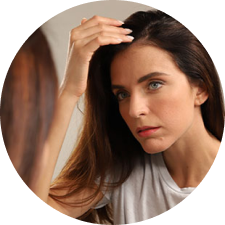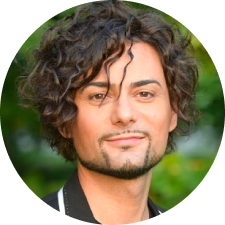- Home
- Hair types and morphology
hair
Hair types and morphology
Scientific collaboration between Professor Marco Toscani and Dr. Pasquale Fino, Chair of Plastic, Reconstructive and Aesthetic Surgery, Umberto I Health Center – “Sapienza” University of Rome.

Some parameters and characteristics should be taken into consideration when assessing hair types and morphologies: shape, density and appearance. The appearance of hair, in the form of lanugo, occurs during the fourth month of pregnancy.
Hair grows at a rate of around 0.3 mm per day, or rather 1 cm per month. It grows longer in women. In any case, this growth tends to diminish with age. The rate of hair growth is more evident in the age range between 10-11 years and 16-18 years of age. These values may vary from person to person. Hair growth cycles last from 2 to 6 years, on average.
There are, however, exceptions, cases in which it can last up to 10 years. At the end of each cycle, the hair falls out and is replaced by a new hair.
Nowadays, the properties and functions of hair are social, sexual and psychological. On the other hand, the hair functions related to protection from external agents or thermoregulation, still present in furry animals, have been lost.
Hair length also varies greatly from person to person. The average length is never more than one meter. It must be noted however that hair can exceed this lenth in certain individuals.
We can distinguish between three types of hair according to shape, according to the appearance that the shaft may take at the base and according to its capillary section, which is determined genetically.
Hair may, therefore, be:
1) cymotrichous: wavy or curly in oval sections, typical of Caucasian races (Europeans);
2) leiotrichous: smooth in round sections, typical of Mongoloid races (Asians);
3) ulotrichous: woolly and dry in flat sections, typical of black ethnicities (Africans).
The hairiest population is the Caucasian one, the Mongoloid population is the less hairy, and the black population is in the middle between these. The various hair types are different in terms of shape, thickness and flexibility, but all share the same chemical characteristics, with keratin being the predominant element. The thickness of hair varies based on ethnicity, and goes from a minimum of 0.06 mm to a maximum of 0.1 mm in Mongoloid races. Leiotrichous hair (Asian) has the largest diameter, followed by cymotrichous hair (Indo-European), while ulotrichous hair (African) is generally finer than all the rest. The diameter, which also varies based on age, is approximately 70 microns (one thousandth of a millimeter), on average. All hair follicles are at an incline with respect to the skin. On the scalp, hair emerges with an incline of around 75 degrees. The number of hair follicles on the scalp at birth is determined genetically. Hair density varies according to the scalp region and is 150 hairs per cm2, on average. Moreover, hair density is correlated with hair color. On average, there are 150 thousand blonde hairs, 110 thousand brown hairs, 100 thousand black hairs and 90 thousand red hairs. The total number of hairs on the scalp is around 100 thousand. The maximum density is seen in those with blonde hair, while the minimum density is seen in those with red hair. Hair can be thick, thin or soft according to the thickness of the cortex and cuticle. The colour of hair is due to melanin (a colored substance). Two types exist: eumelanin, present in dark (black) hair, and pheomelanin, which is instead present in light (red, blonde, golden brown) hair. In blonde hair, the melanin pigments are only present in the cuticle, while in colors ranging from brown to black they are also found in the medulla layer. In red hair the melanin pigments are replaced by widespread soluble pigments. Hair is also rich in minerals that vary according to the color. In red hair we find iron, in black hair we find magnesium and, lastly, lead can be found in brown hair. Hair becomes white due to the loss of the enzymatic exchange between thyroxine and melanocytes. In other words, the cells that produce melanin no longer function correctly. Hair may also suddenly change color due to various causes (fear, illness, etc…)
Hair and Scalp
READ ALL ARTICLESHair Loss
READ ALL ARTICLESHair Problems
READ ALL ARTICLESScalp Problems
READ ALL ARTICLESAlopecia
READ ALL ARTICLESPreventions and Solutions
READ ALL ARTICLESHair loss solutions for you. CRLAB, specialists in the well-being of your hair and scalp.
FIND YOUR NEAREST CENTER
Let our experts find the best solution for you.
FIND YOUR NEAREST CRLAB CENTERBOOK A CONSULTATION
Book a consultation with our experts. Find out more about CRLAB solutions.
MAKE AN APPOINTMENTTrichology scalp and hair care
To put the health back into your hair, you first need to nourish your scalp. Our trichology treatments care for your scalp and hair, using cutting-edge technologies with a full range of laboratory-tested products. All made with high quality raw materials.
Find out moreHair prosthetic system
The ultimate answer to your hair loss. Rediscover yourself, with naturally thick hair. A patented solution that integrates real hair into areas where you’re experiencing thinning or hair loss. A fully customized hair enhancement that will look totally natural on you. Plus, it’s so functional, it gives you the freedom to live your life the way you want to.
Find out moreHair transplant surgery
Hair transplantation is recommended for those who wish to improve hair density and coverage. The degree of thinning may vary and must be assessed in relation to the donor area.
Find out more
 Italiano
Italiano  Português
Português  Français
Français  Español
Español 




